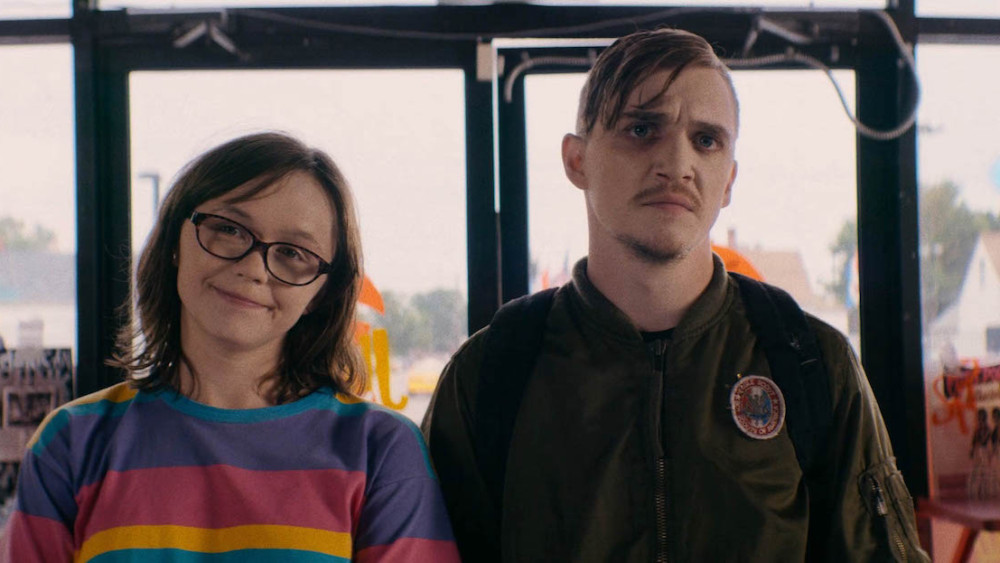Summary
Dinner in America might not be everyone’s taste, but it features star-making performances, a fantastic original song, and a worthy ode to the punk lifestyle.
During the first 15 minutes of Adam Rehmeier’s Dinner in America, you think you understand what kind of movie you’re watching. Profane language, racial and homophobic slurs become commonplace, and central figure Simon (Kyle Gallner) comes into focus. Simon looks like a punk rocker, complete with the ripped tees, half-shaved hair, and a hardness cemented onto his face. We see Simon participate in an experimental food trial for some cash, head over to a girl’s house for dinner, and proceed to hook up with the mother, beat up the son, and set fire to the suburban lawn. This dinner is far from the last one Rehmeier shows us.
On the run, Simon meets with Patty (Emily Skeggs) who shelters him from the closing police force and growing bounty on his head. She takes him to her home, and they sit down for another dinner, one which Simon dominates with religious lies and worthy accusations. Already, Gallner’s character starts to grow on you, and his charm begins to work. Patty loves punk rock music, showing Simon some of her favorites, and the two start spending lots of time together.
The Simon-Patty relationship is odd to start, demeaning and demanding, a one-way street with Patty along for the ride. As they talk more, the audience learns more about Simon, and instead of waiting to reveal the twist towards the end of the film, Rehmeier lays it bare as this comedy grows funnier and more enjoyable by the minute. Patty and Simon go on a series of debaucherous mini-adventures and when the relationship turns romantic, you find yourself smiling. You start to root for these two to succeed individually, as a couple, and as film.
Dinner in America transforms into an ode to punk and a small story with a big heart. The soundtrack remains loud and abrasive, but the film’s lead character in Simon turns into an almost likable anti-hero. So much about him is politically incorrect, unabashedly upsetting, and negating societal standards, but on the flip side, he helps Patty’s family cope and move forward with their lives, mostly through the large amounts of weed now in each of their bodies. He’s not perfect, but none of us are. And by the end of the film, you see that he means less harm than he supposedly flaunts, and his contributions to the community around him are small but meaningful to Patty. He sticks up for her, gives her confidence, and helps her flourish into a character we love and admire.
The film will definitely create a headache for some, with audience members unable to take the first 30 minutes. At times, it feels contrived and unnecessary, leaving you confused at the film’s near-infatuation with a lesser-accepted lifestyle and personality. Though the climax features loud flashes (and tunes), it comes off as rushed, a less-than-fitting end for this couple. The epilogue saves that lackluster climax a bit, but it still feels to be missing something.
The best scene in the movie comes towards the end, as Simon and Patty work in his basement music studio. Most of the edginess has worn away from the film and its characters, and all that’s left is a fascinating relationship. Using Patty’s love letters to the lead singer of her favorite band, the aforementioned twist, the two create an original song, one that cannot be undervalued. It’s one of the catchiest, sweetest songs in a film in some time, and certainly on the top of the list of punk songs written for the screen. Though it might be a long shot, it deserves attention during the next awards season, with any future wins showing a changing Hollywood.
After the third dinner, with Simon’s family, the repetition of this daily tradition makes you wonder about the intricacies of your own families. I found myself thinking of my family’s little problems, big loves, and everything in-between. Rehmeier’s film mirrors its characters though, ditching every supporting character for the two leads in Gallner and Skeggs, employing terrific chemistry and worthy performances.
A few days removed, this film sticks with you for its tender moments, instead of its pulsating punk aura. For a film centered around one of the punkiest characters over the last few years, Dinner in America works best when it focuses on the quiet nature of new relationships, suburban family life, and its stars in the making.



